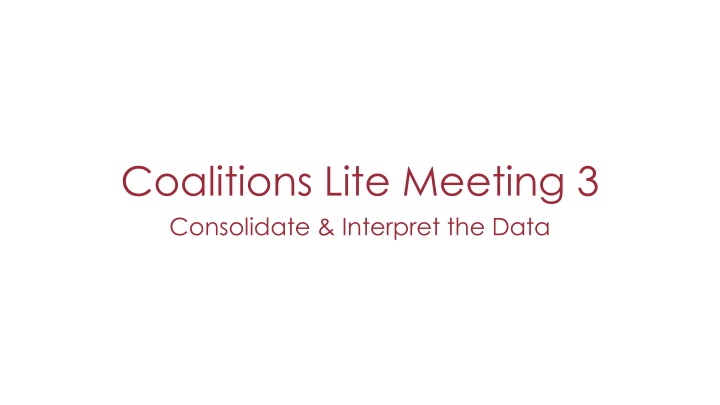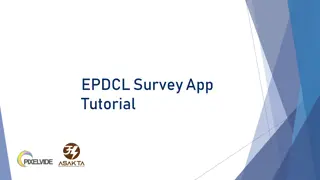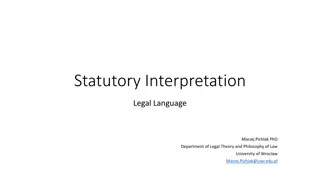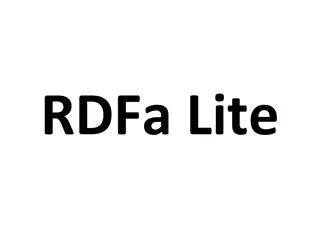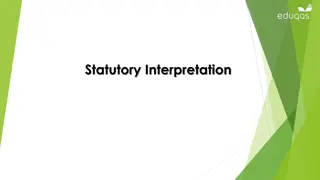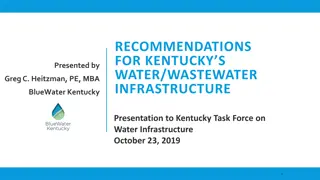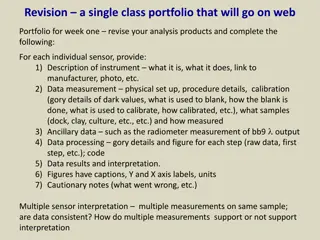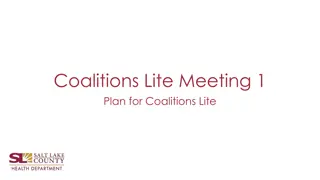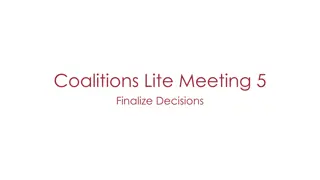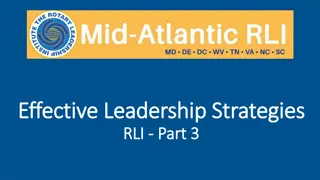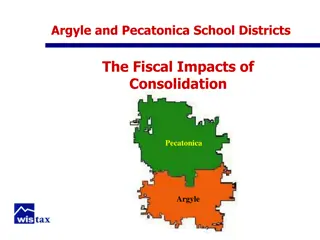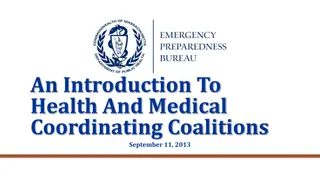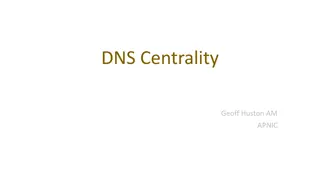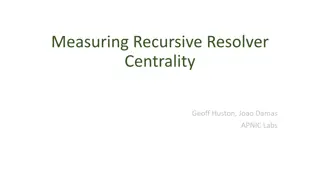Coalitions Lite Meeting 3: Data Consolidation and Interpretation
In the Coalitions Lite Meeting 3, participants focus on consolidating and interpreting data to further define prioritized issues and populations. The agenda includes reviewing progress, selecting relevant data sources, specifying issues, and assigning tasks from previous meetings. Through a structured process, the team aims to enhance understanding and decision-making regarding community issues.
Download Presentation

Please find below an Image/Link to download the presentation.
The content on the website is provided AS IS for your information and personal use only. It may not be sold, licensed, or shared on other websites without obtaining consent from the author.If you encounter any issues during the download, it is possible that the publisher has removed the file from their server.
You are allowed to download the files provided on this website for personal or commercial use, subject to the condition that they are used lawfully. All files are the property of their respective owners.
The content on the website is provided AS IS for your information and personal use only. It may not be sold, licensed, or shared on other websites without obtaining consent from the author.
E N D
Presentation Transcript
Coalitions Lite Meeting 3 Consolidate & Interpret the Data
Welcome, Introductions, & Overview 10 minutes
Meeting Logistics and Overview 1. 2. 3. Team check-in and introductions Identify a notetaker and timekeeper Review access to shared documents
Meeting Objectives 1.Select which data to use 2.Further define the prioritized issue(s) and population(s) 3.Identify the contributing why factors for your issues 4.Outline next steps
Review Progress on Coalitions Lite 5 minutes
Assignments from Step 2 [FILL IN ASSIGNMENTS FROM MEETING #2]
Select Which Data to Use 15 minutes
Data Selection Data source & year : Is the data trustworthy? Is the data new enough to paint a fairly accurate picture of what is happening now? What questions or issues do the data address? : Does the data help us better understand our prioritized issues? Who is represented in the information? : Is the data about a population that s close enough to our community? Are important populations left out? Concerns about the data : Are there any other concerns that would prevent us from using the data? Decision: Based on our responses, do we want to use this piece of data?
Specify Our Prioritized Issue(s) 20 minutes per issue
Data Summary Tools: What does the information mean? (Knowledge Gaps 1 and 2) What does the data say about: 1) How should we further specify the issue? 2) Who is experiencing the issue most?
Specifying Our Issue Altogether, how does all our data suggest we further define the issue? Is there a specific aspect of our broad priority that seems to be more of a problem in our community? Altogether, does our data suggest we should focus on a certain population? We don t have to focus only on the selected population. Outside of our data sources, what do we know of this issue in our community? Does it make sense for us to focus our attention on this specified issue now? What issues have momentum in our community now or where is there a gap we can fill? Is our community ready to address this issue? Do we have the political will for it? What is our final decision? How should we specify the issue and which population should we focus on?
Vote! Fist-to-Five Can you get behind the issue specified this way and focused on this population? Unanimous approval = everyone has at least 3 fingers
Review the Contributing Factor Data 20 minutes per issue
Data Summary Tools: What does the information mean? (Knowledge Gap 3) What does the data say about: 3) What is contributing to this issue or why is it happening in our community?
Decide Priority Contributing Factors 20 minutes per issue
Review Contributing Factors Are there any factors we should remove from consideration because: 1) We only have a vague understanding of it (it s not specific enough to know what action could impact it)? 2) It has conflicting data? 3) Our community may not be ready to address it? 4) We don t have the political will/key stakeholder support? 5) It would take too long to see results? 6) Our coalition couldn t have much impact on the factor?
Dot Vote! Which contributing factors should we prioritize?
Check-In: Thumb Vote! Can you get behind these winning contributing factors? Yes! Maybe, can we discuss? Nope!
Wrap-Up and Next Steps 10 minutes
Meeting #4 Preview DATE: TIME: LOCATION: In Meeting #4, you ll review existing community resources for impacting your contributing factors and begin considering strategies. Meeting #4 will be a working meeting members will be looking up resources and strategies during the meeting. Bring a laptop or tablet! Bring a laptop or tablet!
Assignments Notetaker: Make sure all information and decisions from flip chart sheets are captured in the notes and send the notes out quickly Update and gain approval (if needed) from relevant stakeholders regarding the work done in Meeting #3 In preparation for Meeting #4, get feedback from the coalition or other stakeholders on: existing resources (programs, strategies, service providers, etc.) that address our selected contributing factors any constraints around potential strategies (funding, time, political will, etc.) The Selecting Strategies to Create Change information sheet provides additional information. Anything else?
Check-Out Discussion: How did this meeting go? What worked well or didn t work well with the meeting? How can we run our future meetings better?
The numbers part is over! The numbers part is over!
